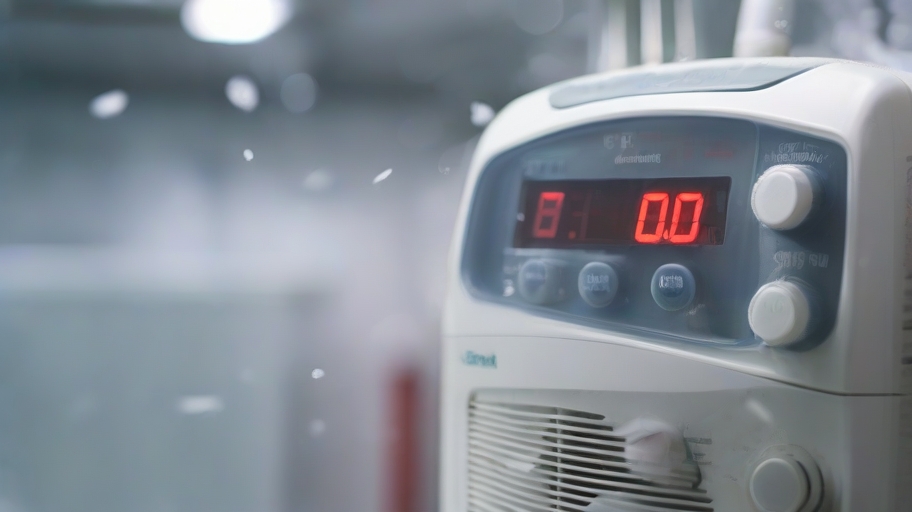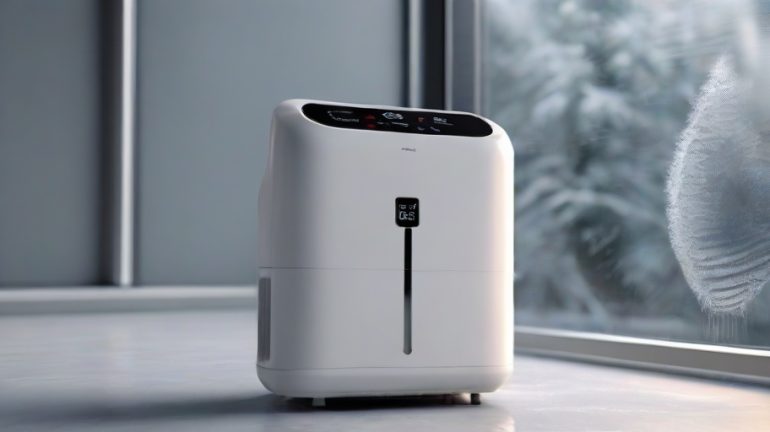Step into the chilly embrace of your basement, where the damp, musty air dances around you. As you ponder the potential benefits of a dehumidifier, a question arises: can these devices function in cold temperatures? Fear not, for I am here to enlighten you.
This article aims to unravel the enigma surrounding the effectiveness of dehumidifiers in cold rooms. Prepare to explore the scientific intricacies of these devices, explore the performance variations among different types in chilly conditions, and discover the secrets to optimising their usage.
Together, we shall dispel the misconceptions and empower you to create a dry, comfortable space, no matter how frigid the surroundings may be.
Understanding Dehumidifiers

To truly grasp the inner workings of a dehumidifier, it’s essential to acknowledge its primary purpose: maintaining an optimal level of humidity in your space, be it warm or cold.
Even in chilly temperatures, these ingenious appliances can effectively extract moisture, although their efficiency may be slightly compromised.
It’s worth noting that extremely frigid weather can push the humidity level below the ideal range of 40-60% relative humidity that these devices strive for. This can exert strain on the dehumidifier and potentially lead to malfunction.
Thus, comprehending the nuances of dehumidifiers and their limitations in cold conditions is pivotal for maintaining a comfortable and healthy environment in your humble abode or bustling office, regardless of the weather conditions outside.
How Dehumidifiers Work in Cold Environments
Even chilly temperatures won’t dampen their effectiveness when you grasp how they operate in such environments. When faced with cold rooms, it’s crucial to note that conventional compressor dehumidifiers may struggle to perform, unlike their counterparts, the desiccant dehumidifiers, specially designed for such conditions.
These appliances not only extract excess moisture from the air but also generate warmer air, making them perfect for use in cold settings. However, keep in mind that dehumidifiers function in cold rooms by drawing in cold air, removing its moisture, and then recirculating it back into the room, rather than warming the entire space.
Hence, it’s imperative to ensure that the dehumidifier you choose is well-suited for the specific cold room you intend to place it in.
The Impact of Temperature on Performance
When the temperature drops in colder rooms, the performance of your device can be significantly impacted. It’s especially noticeable when you try to use a dehumidifier in cold weather. Let’s explore three key impacts that temperature has on the performance of your apparatus:
- Efficiency: While dehumidifiers can still work in chilly rooms, their efficiency reduces as the temperature drops. In lower temperatures, they become less effective at extracting moisture from the air.
- Functionality: Extremely cold conditions can cause your dehumidifier to struggle with proper functionality. The coils may freeze, leading to malfunctions and hindering its performance.
- Moisture Levels: Cold weather often brings lower humidity levels. Consequently, your dehumidifier in a cold room may collect less water than usual. This is because the moisture becomes more concentrated in the form of snow or ice.
Understanding the impact of temperature on your dehumidifier’s performance is crucial for optimising its effectiveness. Whether it’s reduced efficiency, potential functionality issues, or altered moisture levels, being aware of these impacts can help you make informed decisions when using your dehumidifier in colder environments.
What Type of Dehumidifier Works Better
When it comes to dehumidifiers and their performance in colder weather, it’s worth noting that desiccant ones tend to outperform traditional models in these conditions. Specifically designed for cold rooms, these dehumidifier models excel at efficiently removing moisture from chilly environments.
Unlike traditional compressor dehumidifiers that rely on a coil system which can struggle in the cold, desiccant dehumidifiers work better by generating warmer air, thereby providing an additional source of heat to the room.
Not only are they more effective, but they also offer the added benefits of quiet operation and easy maintenance, making them a superior choice for dehumidifying a chilly room and preventing the appearance of mould and moisture.
Tips for Using Dehumidifiers in Cold Rooms

If you’re looking to dehumidify a cold room, there are a series of essential steps you should follow to ensure optimal performance.
The first and foremost crucial step is selecting the most suitable one for cold weather conditions. In this case, your best dehumidifier is a desiccant dehumidifier, which efficiently operates in low temperatures.
Now, let’s step into some additional tips to effectively utilise dehumidifiers in freezing rooms:
- Maintain a warm, dry, and well-ventilated room. This will significantly enhance the effectiveness of your dehumidifier by creating an environment that encourages moisture removal.
- Utilise a humidistat. This handy device enables you to set and control the desired humidity level in the room. It acts as a guiding light, ensuring your dehumidifier operates efficiently and effectively.
- Avoid placing your dehumidifier near cold surfaces. Doing so prevents freezing and condensation issues that may arise. By keeping your dehumidifier away from low-temperature surfaces, you safeguard its performance and longevity.
It’s important to note that dehumidifiers may experience a reduction in performance when operating in colder temperatures. Therefore, monitoring its performance regularly and cleaning or replacing the filter as needed to maintain optimal function is advisable.
Frequently Asked Questions
What temperature do dehumidifiers require to function?
Dehumidifiers are designed to operate within a specific temperature range, typically between 10°C and 35°C. Outside this range, the performance may be compromised.
Will the dehumidifier continue to remove moisture in cold rooms?
These appliances may experience challenges in colder temperatures, such as the coil on the unit freezing up. Built-in defrost features help address this issue and allow the device to continue extracting moisture.
Is there a difference in energy consumption between using a dehumidifier in colder versus warmer rooms?
These devices generally consume more energy in colder rooms due to the extra efforts required to operate in lower temperatures. It’s important to keep an eye on energy usage and consider energy-efficient settings or features.
How do dehumidifiers function in cold spaces during the winter months?
In colder rooms, dehumidifiers need to work harder to cool the air and remove excess moisture. Heating elements and refrigerants are utilised to prevent the coils from freezing up and ensure efficient operation.
Can using a dehumidifier in a chilly room lead to condensation on windows and walls?
These devices help reduce excess moisture, which can minimise condensation on windows and walls. However, it is also important to check for proper insulation and ventilation to prevent condensation issues.
Aside from a dehumidifier, are there any other methods to control moisture levels in freezing rooms?
Additional actions can include proper insulation, ensuring adequate ventilation and using moisture-absorbing materials like silica gel.
Is it normal for a dehumidifier to stop collecting water in colder months?
It is not unusual for a dehumidifier to collect less water in colder months due to lower moisture levels in the air. This does not indicate that the dehumidifier has stopped working, but rather that there is less moisture to extract.

